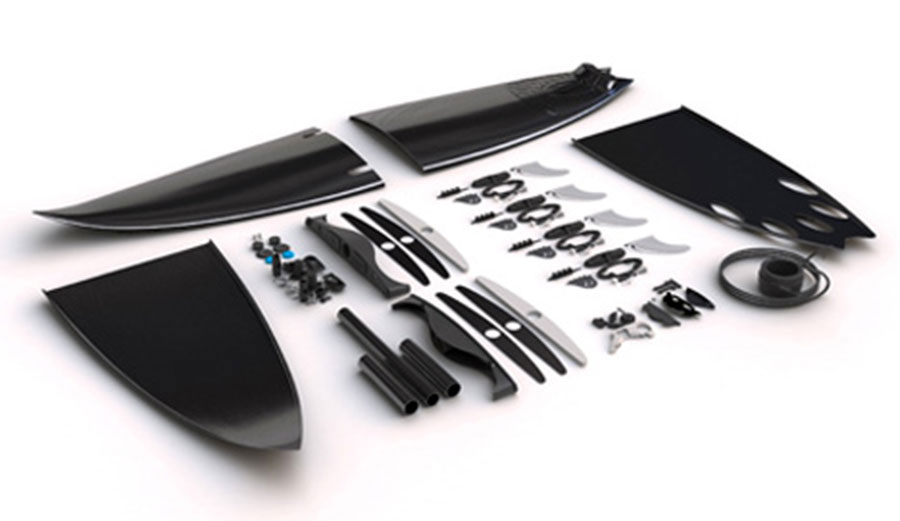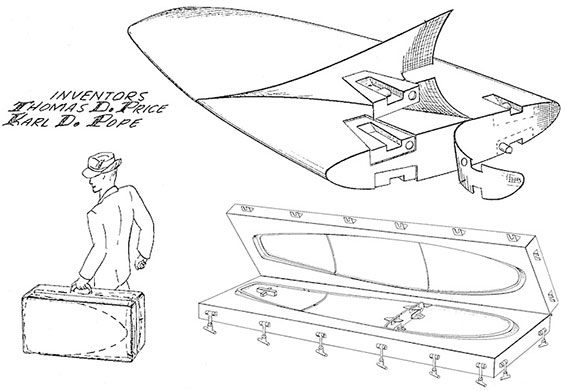
If only someone would make one that ACTUALLY worked! Image: Yanko Design
If you’ve flown anywhere to surf, you’ve probably griped about airline surfboard fees. Depending on the airline, you’re paying through the nose for your surfboard while the guy in the business suit behind you is paying pennies for his 100 pounds of golf clubs. It’s always been an issue, but now that social media exists, surfers are able to call attention to the fact that airlines are gouging the shit out of surfers. First, there was John John vs JetBlue. Next, there was Bob Hurley/Kelly Slater vs. Hawaiian Airlines.
Before we get to the meat of this, let’s have a look at what happened to JetBlue after they accidentally fed John’s quiver to a pack of rabid beavers and held onto the $500 bucks he shelled out. Of course, as is almost always the case, there is two sides of the story. JetBlue’s website reads thusly: “One (1) surfboard per case; size and weight restrictions do not apply, except items weighing more than 100 pounds will not be accepted as checked baggage. We recommend that surfboards travel in a hard-sided (rather than soft-sided) case to prevent damage.”
Despite their rules, JetBlue spent the month after John John’s post fielding a long string of hate mail, which, as far as I can see, did nothing except annoy the people fielding it. Now, I can’t be sure about this, but it looks to me as though John John may have packed a little more than one surfboard in there. Which is probably going to be the case with Hawaiian Airlines after Bob Hurley, the original firestarter of the five alarm blaze that is currently burning down Hawaiian Airlines social media posted his rant and Kelly Slater picked it up. They looked at the rules, tried to shirk them, then went to Instagram to complain. But just because there are rules doesn’t mean the rules make any sense. Surfers are getting ripped off by bullshit rules, and airlines sit back, laugh, shrug their shoulders and say, “everyone else is doing it!”
In a nutshell, we’re screwed, so let’s have a look at a couple of options that, while they may not work very well on a wave, would be much better to travel with… if only they ever actually became an option. Of course, the collapsable surfboard has never really caught on, but people have been toying with the idea for decades now. Here are three of them.
1. The Pope Bisect

The first patent on a collapsible surfboard.
Back in 1964, Thomas Price and Karl Pope registered the first patent for a collapsible surfboard. According to New Atlas, Pope spent the next three decades mulling over how, exactly to make his idea work. He was an aerospace engineer, and what he came up with sounded pretty good. It was called the Pope Bisect Stealth, a 9’6 hollow carbon fiber board that broke into two pieces.
Then, Pope started a business called Bisect that, as far as I can tell, failed pretty spectacularly after a series of terrible customer service catastrophes and generally bad business practices including shipping broken products, failure to fix their broken products, and bounced refund cheques. Here’s a forum full of horror stories.
2. Herman Bank’s Suitcase Surfboard

Herman Bank, creator of the “Suitcase Surfboard.” Photo: LA Times
In 1966, a few years after Price and Pope filed the patent for what would become the Bisect, a young engineer named Herman Bank created what he called The Multiboard. It would become known more commonly as the “suitcase surfboard” and despite half way decent review, it, like all the others, would never catch on. The Multiboard, though, has a very interesting story behind it.
According to the LA Times, Bank worked at the famed Jet Propulsion Laboratory in the ’60s. Although he was part of the so-called Rocket Boys–a group of hyper-intelligent scientists that helped NASA propel the space age–he also surfed. He hated strapping his surfboard to the roof of his car, so like any good engineer, he devised a way around it. In the words of the LA Times, the story goes like so: “After securing his cargo alongside a Los Angeles freeway, Bank puzzled over how to make the era’s nearly 10-foot-long boards easier to transport. A son who surfed persuaded him that the answer was to slice them in two.” Which is exactly what he did.
In a few months, he’d designed a surfboard that broke apart for travel and was easily and quickly put back together. For a while, many manufacturers lauded it as the next big thing. Then the shortboard revolution took root, and the need evaporated. The Multiboard was “a quick little splash in the evolution of surfboards,” said Dick Metz, the founder of the Surfing Heritage Foundation. “It was a good idea, but the market wasn’t there.”
Before the market dried up, though, Bank was called upon to convert a couple of Hobie Boards for The Endless Summer. Although they were never used, apparently they actually worked pretty well.
“The board would vibrate some,” said Ron Bank, his surfer son, who probably was a bit biased. “It wasn’t as tight as we hoped it could be, but you could ride the hell out of it. It was a decent board.” By 1967, Multiboard Co. closed its doors for good. Banks went on to design several other devices that never caught on, like a spring loaded fishing pole. He went on to do much more important things in the field of medicine including creating of a bag that increased the shelf life of blood and an X-ray technique that used less radiation before he died in 2012 at the age of 96.
3. Nicholas Notara’s Collapsible Surfboard

If only someone would make one that ACTUALLy worked! Image: Yanko Design
As far as I can tell, this one’s nothing more than a prototype. Made from carbon fiber, Nicholas Notara built a board that looks like something out of Air Wolf. Called the C2, the board broke apart with two pins and a quick-release lever. I can’t find out much about it or the designer, but it made some waves online for a few short months and then disappeared into the abyss.
Now, there are a few that almost got off the ground. Walden, for instance, built the Tri-Fold for a short period of time. Surfline’s review of it was pretty solid, but they don’t seem to exist anymore. There’s a company called Multiple Exchange Surfboards that, instead of concentrating on the travel aspect of break-apart surfboards, concentrates on the fact that they’re simply inter-changeable. There’s North Shore Travel Boards, which, although it looks to be one of the only companies out there actually making a product one can buy, claims to be the “”Original’ Home of the Multiple Piece Travelboard.” NSTB calls many of their boards Bisects, so it could just be another iteration of the Pope Bisect.
Whatever the case may be, it’s clear there’s a need for a surfboard that actually comes apart. But who’s going to be the one to fill that need with a surfboard that actually works?

